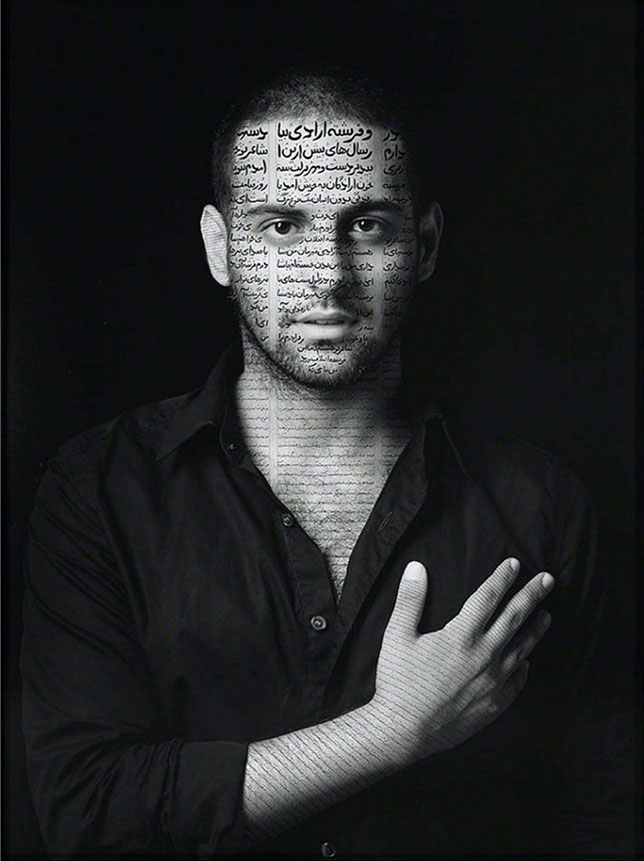Born in Iran, Shirin Neshat (1957) moved to the United States in 1974 to study at the University of California at Berkeley, earning a BA and MA in fine arts in 1983. Soon after graduation, she moved to New York City, where she worked at the Storefront for Art and Architecture for 10 years. It wasn’t until returning to Iran in 1993, 14 years after the Islamic Revolution, that she began to once again create art.
Known for her work in photography, video, and film, Neshat’s projects often explore various oppositions, from Islam and the West to male and female. As she explained in an exhibition hosted by the Art 19 fundraising initiative, “It has always been my opinion that artists should be politically conscious and in my personal case being born as an Iranian, a country that has undermined basic human rights particularly since the Islamic revolution, I have uncontrollably gravitated toward making art that is concerned with issue of tyranny, dictatorship, oppression and political injustice. Although I don’t consider myself an activist I believe my art regardless of its nature, is a expression of protest, and a cry for humanity.”
Her first video installations—Turbulent (1998), Rapture (1999), and Fervor (2000)—examined gender and society, specifically the restrictiveness of Islamic laws against women; her first feature film, Mahdokht (2004), based on Shahrnush Parsipur’s novel Women Without Men, similarly also the topic. Her film Women without Men (2009), which won the prestigious Silver Lion award at the Venice Film Festival, follows four women—including a political activist, a prostitute, and a would-be mother—set in the context of 1950s Iran and featuring surreal elements to convey the psychological states of her characters. More recently Neshat has collaborated with American artist Larry Barns, taking portrait photographs of elderly, low-income Egyptian workers, including mechanics, street peddlers, teachers, grandmothers, and housewives, exploring the hardship experienced by individuals living under tumultuous regimes. “Today, again in the comfort of my sanctuary in New York, I look back and wonder how they are,” she says. “What is the future for Egypt? Is there any hope for return of that revolutionary fervor which seemed so pure, beautiful, and powerful?” Neshat has also collaborated with composer Philip Glass and the singer-songwriter Sussan Deyhim.
© 2021. All content on this blog is protected by international copyright laws All images are copyrighted © by Shirin Neshat or assignee. Apart from fair dealing for the purpose of private study, research, criticism or review as permitted under the Copyright Act, the use of any image from this site is prohibited unless prior written permission is obtained. All images used for illustrative purposes only

 |
Ms. Shirin Neshat at work
|
 |
| Ms. Shirin Neshat |
 |
| Allegianc with Wakefulness, 1993 |
 |
| Birthmark, 1994 |
 |
| from 'Women of Allah', 1994 |
 |
| Rebellious Silence, (from 'Women of Allah'), 1994 |
 |
| Seeking Martyrdom, 1994 |
 |
| 1995 Untitled (from 'Women of Allah'), 1995 |
 |
| Speechless (from 'Women of Allah'), 1996 |
 |
| Untitled, 1996 |
 |
| Mystified, 1997 |
 |
| Careless, 1997 |
 |
| On Guard, 1998 |
 |
From 'Rapture', 1999
|
 |
| I Am It's Secret, 1999 |
 |
| Untitled (from 'Soliloquy' ), 1999 |
 |
| Untitled, (from 'Rapture' ) 1999 |
 |
| women in a line (from 'Rapture'), 1999 |
 |
| Fervor, 2000 |
 |
| Modern Building ( from 'Sililoquy'), 2000 |
 |
| Passage, 2001 |
 |
| Passage, 2001 |
 |
| Untitled, 2005 |
 |
| Malik (from 'Zarin'), 2007 |
 |
| Mehri (from "Zarin"), 2007 |
 |
| Seeking Martyrdom (From ‘Women of Allah’), 2007 |
 |
| Untitled (from 'Zarin'), 2007 |
 |
Untitled (From ‘Women of Allah’), 2007
|
 |
| Book of Kings installation view, 2012 |
 |
| Ibrahim (from 'Book of Kings' ), 2012 |
 |
| Sara Khaki (Patriots), (from “ Book of Kings”), 2012 |
 |
| Hamid from 'Our House is on Fire', 2013 |
 |
| From 'Roja' Series, 2016 |


































No comments:
Post a Comment